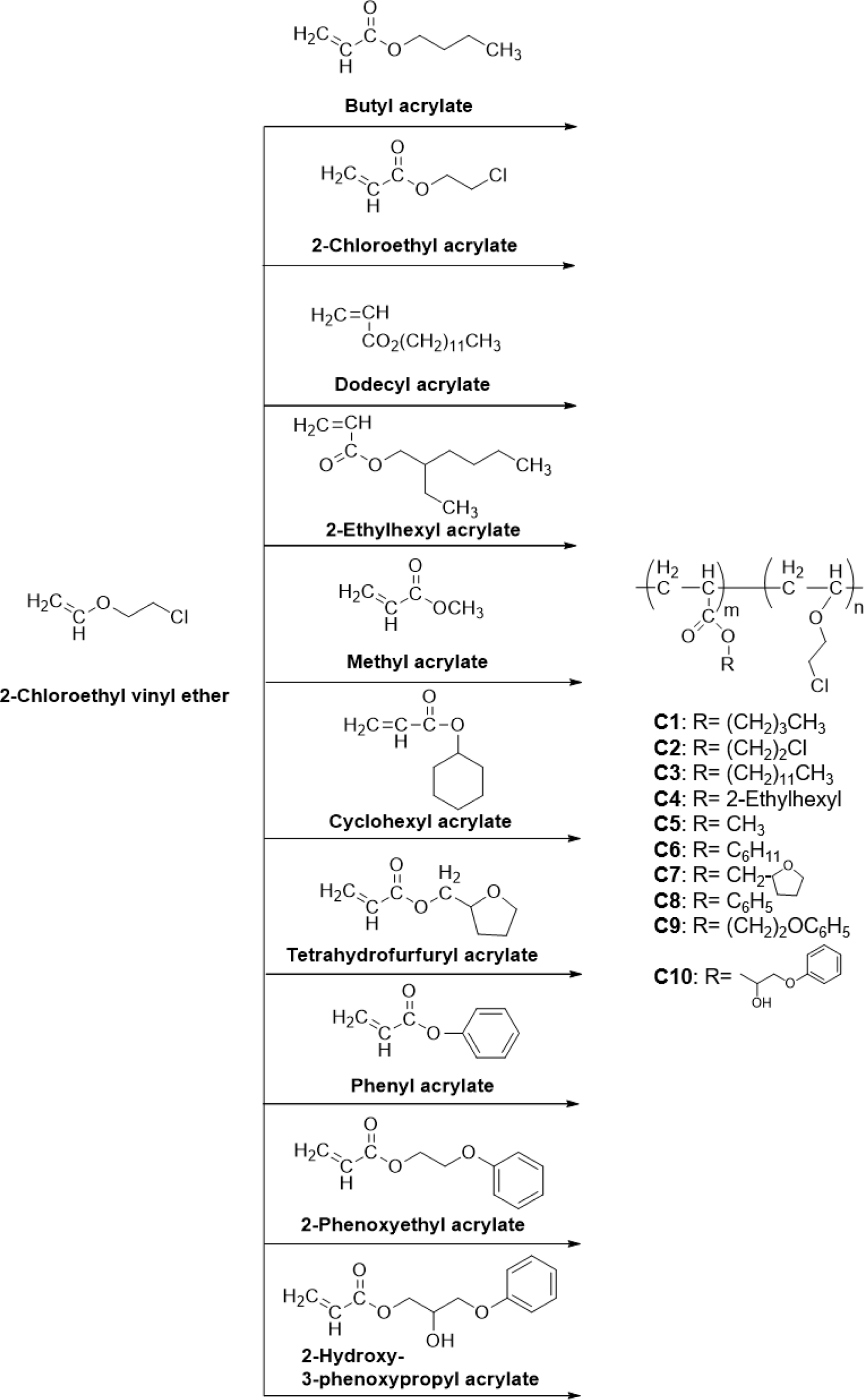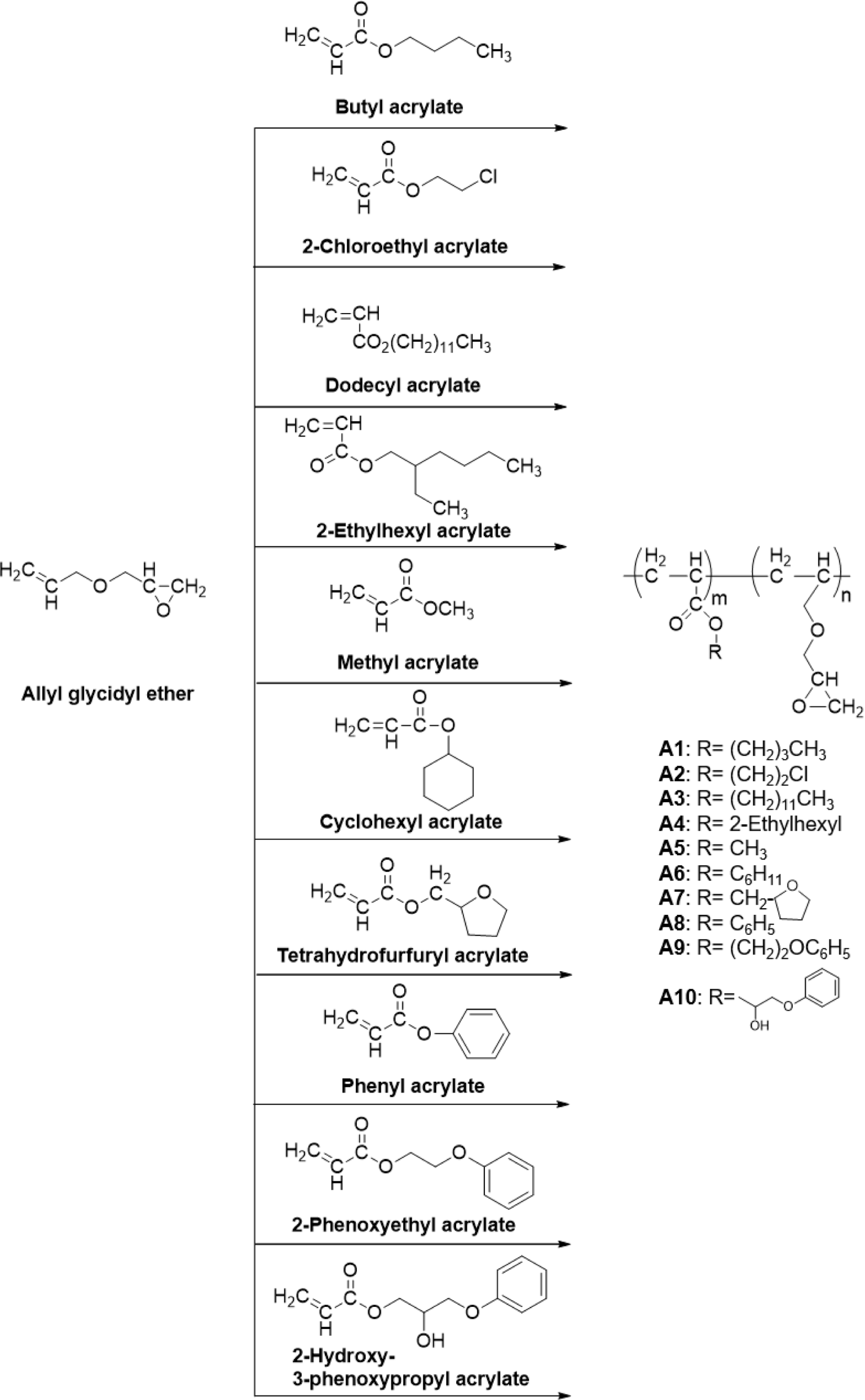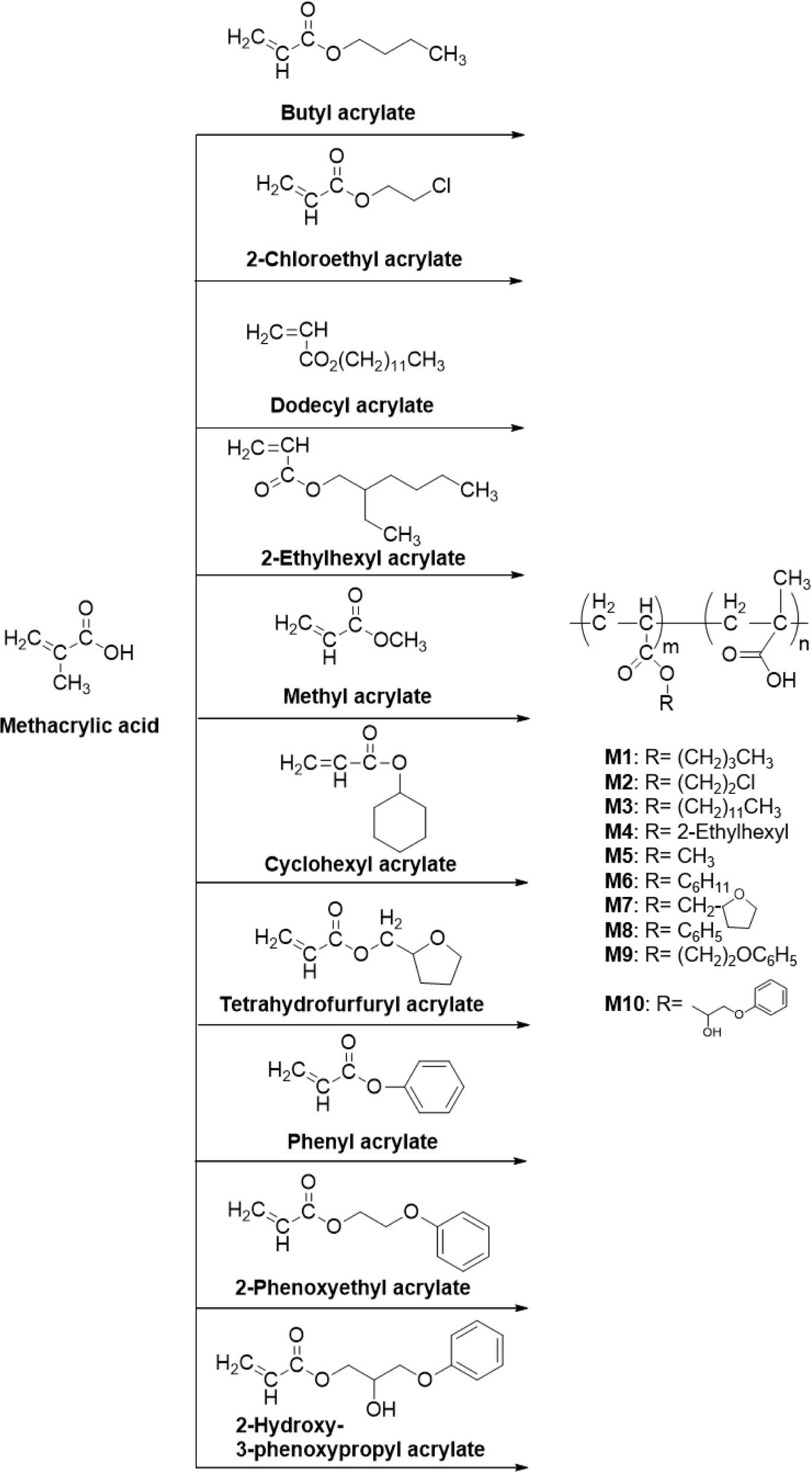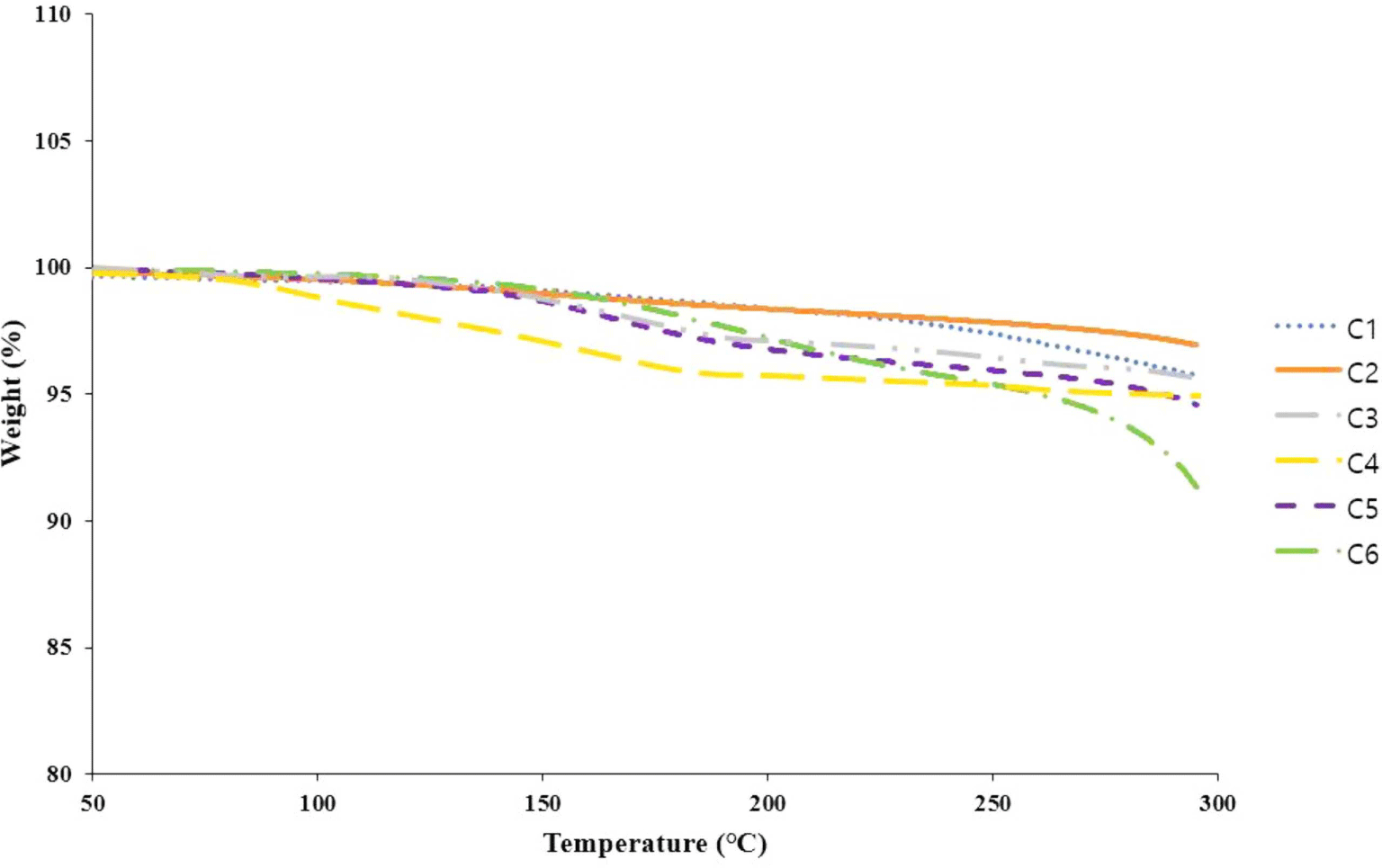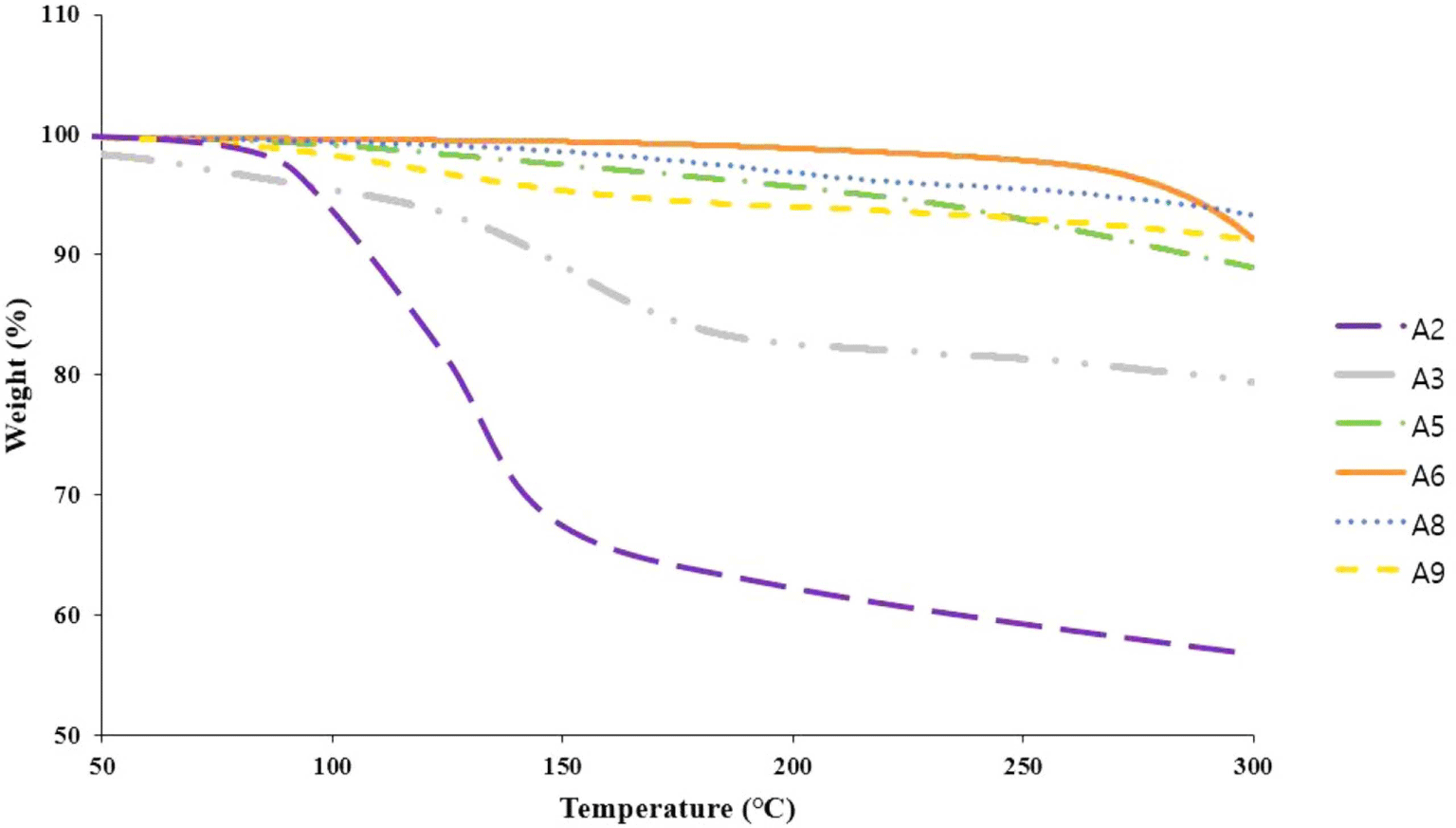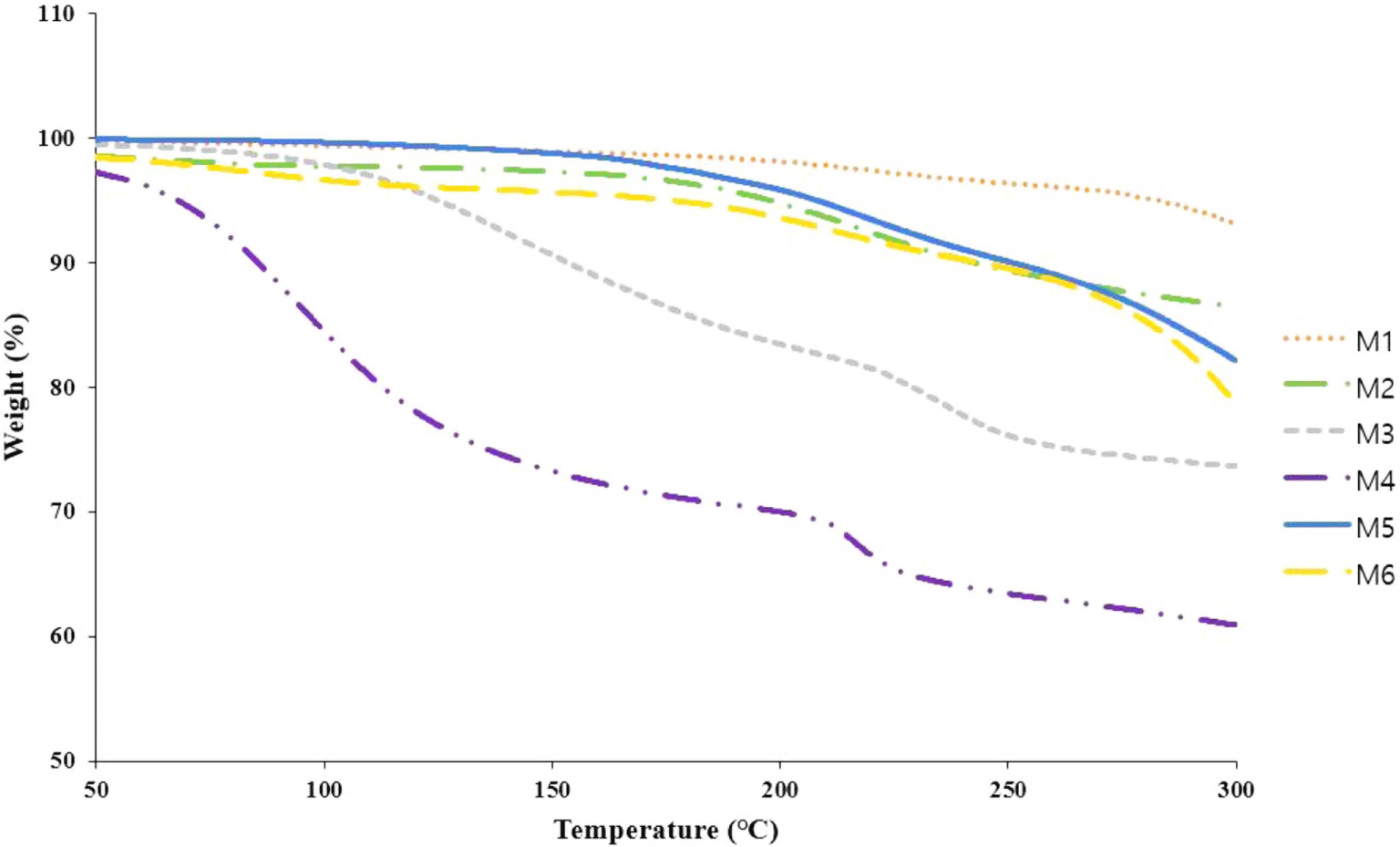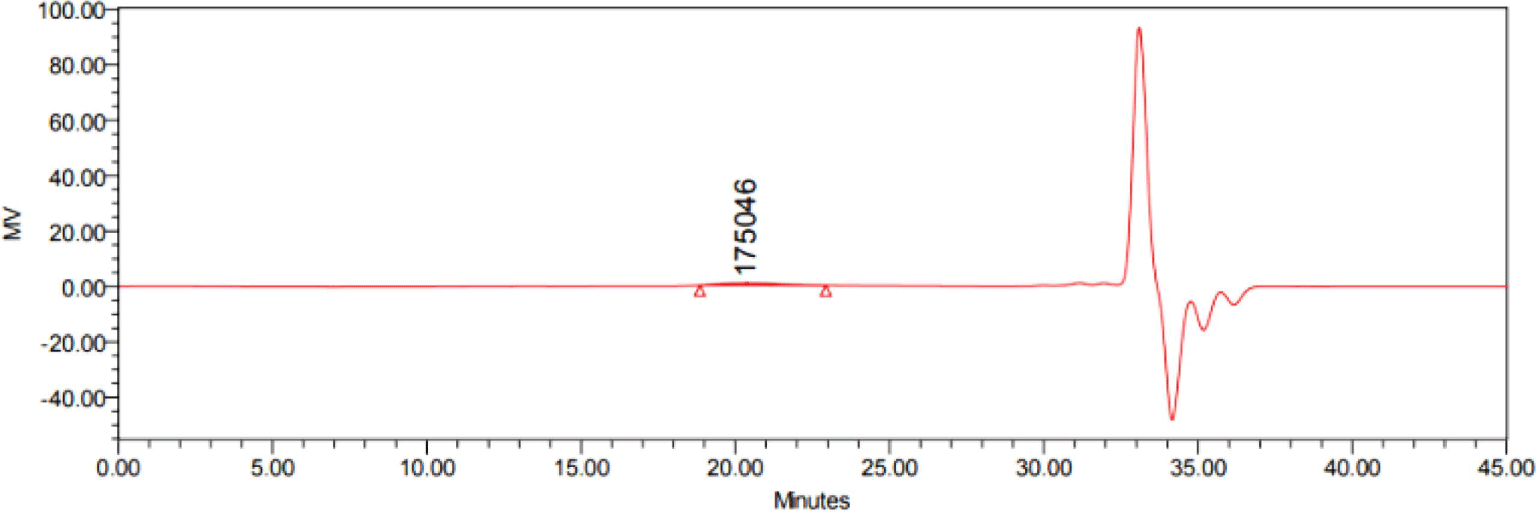Introduction
아크릴레이트계 중합체는 탄성소재용 고무 뿐만 아니라 최근까지 다양한 응용분야로 연구가 진행되고 있는데, n-butyl acrylate와 methyl ether acrylate 공중합체의 나노구조 형성에 의한 약품전달소재,1,2 phosphate monoester계 아크릴레이트를 사용한 난연성 중합체,3 core-shell alkyl acrylate 중합물을 사용한 코팅소재,4 2-methoxyethyl acrylate 기반 나노조성물 탄성소재,5 tetrahydrofurfuryl acrylate, 2-phenoxyethyl acrylate, vinyl acetate, vinyl carbazole 등 4종 모노머를 사용한 공중합체의 holographic 기록소재,6 methylene linker와 azobenzene을 함유한 poly(meth)acrylate의 액정특성,7 sodium alginate와 ethyl acrylate의 생분해성 공중합체,8 3종 alkyl acrylates와 polyvinyl chloride의 3D 프린팅용 공중합체9 등 연구논문이 최근 발표되었다.
본 연구에서는 고무호스, 씰 및 가스켓과 같은 자동차부품으로 사용되는 고무소재중에서 내열, 내한 및 내유성을 요구수준을 충족하는 아크릴레이트계 공중합체(ACM계)의 중합연구에 관한 것으로, 일반적으로 자동차부품용 탄성소재로서 아크릴고무(ACM rubber), 실리콘고무, 수소화 아크릴로 니트릴고무(HNBR, hydrogenated NBR), 염소화 고무 등이 사용되나 180°C~200°C의 내열성과 -50°C 이하 내한성과 같이 요구조건이 점차 엄격해지면서 아크릴고무에 대한 기술개발이 가장 활발하게 진행되고 있다. 하지만 아크릴 공중합체의 내열성 및 내한성에 미치는 단량체의 영향성에 대한 연구결과가 매우 부족하여 우수한 내열성 혹은 내한성을 가진 아크릴레이트계 공중합체를 개발하는 것이 많은 실험을 통해서 진행되어야만 하므로, 본 연구에서는 2종 단량체(아크릴레이트계 주 단량체 및 가교 단량체)의 화학구조가 공중합체의 내열성 혹은 내한성(Tg 값)에 미치는 영향성에 대한 연구를 수행함으로서 최적의 2종 단량체를 선정하는 효율적인 연구방법을 고찰하였다.
Experimental
본 연구를 위해 사용된 ACM 중합체의 원료 중 n-butyl acrylate, n-dodecyl acrylate, 2-ethylhexyl acrylate, cyclohexyl acrylate, phenyl acrylate, 2-phenoxyethyl acrylate, 2-hydroxy-3-phenoxypropyl acrylate, 2-chloroethyl vinyl ether, allyl glycidyl ether, methacrylic acid는 TCI사로부터 구입하여 중합금지제 제거 후 사용하였으며 2-chloroethyl acrylate, methyl acrylate는 SIGMA-ALDRICH사로부터 구입하여 중합금지제 제거 후 사용하였다. Tetrahydrofuryl acrylate는 ALFA AESAR사의 제품을 중합금지제 제거 후 사용하였다. 중합 시에 사용하는 sodium bicarbonate, sodium dodecyl sulfate, potassium persulfate는 각각 DUKSAN사, TCI사, SIGMA-ALDRICH사의 제품을 정제 없이 그대로 사용하였다. 중합금지제 제거를 위해서는 DUKSAN사의 Sea sand, SIGMA-ALDRICH사의 aluminium oxide 및 ACROS사의 molecular sieves 4A, 4 to 8 mesh 제품을 정제 없이 그대로 사용하였다. Tetrahydrofuran은 DUKSAN사의 제품을 사용하였다.
본 연구에서 사용된 각 단량체들은 중합 전 컬럼을 통해 중합금지제를 제거하였다. 이때, 컬럼은 아래에서부터 솜, sea sand, aluminium oxide 순으로 쌓아준다. 컬럼 후 단량체 시약 보관 시에는 수분과의 라디칼 반응이 일어나 분자량이 떨어지는 현상을 막기 위해 molecular sieves를 바이알에 함께 보관하여 수분 흡착을 시켰다.
유화중합은 부가중합에 의해 중합될 수 있는 고분자의 생산에 사용되는 중합 방법으로 반응계는 단량체와 분산매, 계면활성제, 개시제로 이루어진다. 물을 용매로 하여 반응액의 유동성이 좋은 상태로 유지되므로 반응열의 분산이 쉽다. 이에 개시제 농도나 중합온도를 낮추는 것이 필요 없어 생산량의 감소로 이어지지 않는다. 고무로서의 탄성을 가지기 위해서는 분자간의 걸침이 많은 고분자량의 중합체가 필요하므로 대부분의 아크릴계 탄성체는 유화중합에 의하여 생산되고 있다.
본 연구에서는 주 단량체 10종으로 n-butyl acrylate, 2-chloroethyl acrylate, n-dodecyl acrylate, 2-ethylhexyl acrylate, methyl acrylate, cyclohexyl acrylate, tetrahydrofuryl acrylate, phenyl acrylate, 2-phenoxyethyl acrylate, 2-hydroxy-3-phenoxypropyl acrylate와 가교 단량체 2-chloroethyl vinyl ether, allyl glycidyl ether, methacrylic acid 3종을 각각 유화중합을 통해 유화공중합체를 제조하였다. 합성된 각 중합체의 이름은 주 단량체 10종 순으로 1부터 10까지 표기하고 가교 단량체 3종은 각각 C, A, M으로 표기하여 n-butyl acrylate와 2-chloroethyl vinyl ether의 중합체를 C1, 2-chloroethyl acrylate와 2-chloroethyl vinyl ether의 중합체를 C2로 표기하였고 30종의 합성된 중합체는 C1-C10, A1-A10, M1-M10로 표기하였다.
합성된 유화공중합체의 중합 방법은 다음과 같다. 반응기에 주 단량체 3g, 가교 단량체 2g을 투입하고 밀폐 후 15분간 교반한다. 다른 비커에 물 20g, sodium bicarbonate 0.01g, sodium dodecyl sulfate 0.1g을 투입 후 교반한다. 교반 후 단량체를 물이 든 반응기에 투입하고 밀폐한 후 30°C에서 20분간 교반한다. 라디컬개시제로 과황산칼륨(potassium persulfate) 0.01g 투입 후 질소 조건 하에서 70°C로 승온하고, 70°C 도달 후 3시간 반응시킨다. 반응 완료 후 중합 생성물을 tetrahydrofuran (50g)과 물(500g) 용액에 투입하고 이때 생성된 고체를 필터하고 건조 후 최종 생성물을 수득한다. 주 단량체 10종과 가교 단량체 2-chloroethyl vinyl ether로 중합한 중합체의 합성 경로는 Scheme 1에 나타내었다. 주 단량체 10종과 가교 단량체 allyl glycidyl ether로 사용한 중합체의 합성 경로는 Scheme 2에 나타내었다. 주 단량체 10종과 가교 단량체 methacrylic acid로 중합한 중합체의 합성 경로는 Scheme 3에 나타내었다.
중합된 고분자 30종은 AUTO-Thermogravimetric Analyzer (Q500, TA Instruments)에 의해 질소 조건 하에서 50°C에서 500°C까지 승온속도 10°C/min 조건으로 측정하였다.
Results and Discussion
주 단량체를 중심으로 열안정성에 미치는 영향성을 규명하기 위하여 아크릴레이트계 화합물로서 탄소수 1개/4개/7개/12개의 알킬기, 2-chloroethyl기와 같은 알킬그룹이거나, cyclohexyl, tetrahydrofurfuryl, phenyl, phenoxyethyl기와 같은 cyclo그룹을 가진 10종의 주 단량체를 선정하여 3종의 가교 단량체와 각각 중합을 수행하였고 총 30종 중합물의 화학구조와 반응식을 Scheme 1~Scheme 3에 기재하였다.
아크릴레이트계 단량체를 사용한 중합은 일반적으로 단량체, 개시제 등을 유기용제 사용하에서 유화중합으로 진행하는데10-14 유사한 구조를 가진 polyurethane계 중합온도가 100°C 이상의 고온인 반면15,16 아크릴레이트계 유화중합은 상대적으로 낮은 온도인 100°C 미만이 일반적이므로 본 연구에서는 중합온도를 70°C로 설정하여 합성을 수행하였다. 중합온도가 공중합체의 평균분자량에 영향을 미치지만 본 연구에서는 동일한 온도에서 2종 단량체의 화학구조와 내열성(TGA 무게감소율) 연관성을 고찰하는 것이 주 목적이므로 중합온도 변화에 따른 내열성 연관성 연구는 포함되지 않았다.
또한 중합시간도 2종 단량체의 중합반응성에 연동하여 평균분자량에 어느정도 영향성을 가지나 본 연구에서는 동일하게 70°C에서 중합시간 3시간을 유지하고 생성된 중합체의 TGA에 의한 무게감소율과 DSC에 의한 Tg값을 분석하였다.
라디컬개시제로는 과황산칼륨(K2S2O8)을 사용하였는데 이는 이중결합을 보유한 alkene 화합물의 개시제로 많이 사용되는 것으로 용액상태에서 이중 음이온(dianion, [O3SO-OSO3]−2)이 라디컬(SO4 radical)을 발생하는 특성을 가진다.17
중합반응이 종결된 반응물을 1:10 비율로 혼합한 tetrahydrofuran/물 용액에 투입하여 생성된 고체를 여과함으로서 최종 공중합물을 고체상태로 얻는다. 이때 중합반응에 미참여한 잔존 단량체는 tetrahydrofuran에 용해되어 제거되고 또한 소량 존재하는 과황산칼륨은 물에서 분해되어 제거됨으로서 고체로 분리된 공중합체의 순도를 증대할 수 있었다.
중합체의 기본적인 열안정성은 일반적으로 TGA분석에 의한 무게감소율을 기준으로 평가하는데, 고정된 온도에서 무게감소율/ 무게유지율을 상대적으로 비교하거나 혹은 동일한 무게감소율이 발생하는 온도를 기준으로 평가하는 방법이 사용되고, 본 연구에서는 중합된 아크릴레이트계 중합체가 적용되는 자동차부품분야에서 요구되는 내열성 수준인 200°C를 기준으로 합성된 30종 공중합체의 무게감소율을 상대적으로 비교 분석하였다.
먼저 주 단량체의 화학구조에 의한 공중합체 무게감소율 영향성에서, 주 단량체의 알킬그룹 탄소수(carbon chain)가 짧아질수록 무게감소율이 적어져서 열안정성이 증대하는 것으로 판단된다. 예를 들어 동일한 가교 단량체를 사용하여 탄소수가 다른 주 단량체와의 공중합체의 무게감소율을 비교하면, 2-chloroethyl vinyl ether를 가교 단량체로 사용하고 탄소수 4개인 n-butyl group과 2개인 ethyl group을 보유한 주 단량체를 사용한 공중합체인 C1 및 C2의 무게감소율이 각각 1.25% 및 1.41%인 반면 탄소수 12개인 n-dodecyl group과 7개인 2-ethylhexyl group을 보유한 주 단량체를 사용한 공중합체인 C3 및 C4의 무게감소율이 각각 3.13% 및 4.65%로서 상대적으로 C1과 C2의 무게감소가 적게 발생하였다(Table 1). 특히 methacrylic acid를 동일한 가교 단량체로 사용할 경우 알킬그룹 탄소수가 무게감소율에 미치는 영향성이 더욱 커지는 것으로 분석되었는데, 탄소수 4개인 n-butyl 기, 2개인 ethyl기, 1개인 methyl기를 보유한 주 단량체를 사용한 공중합체인 M1, M2, M5의 무게감소율이 각각 1.60%, 3.74%, 4.06%로서 탄소수 12개인 n-dodecyl group과 7개인 2-ethylhexyl group을 보유한 주 단량체를 사용한 공중합체인 M3 및 M4의 무게감소율 15.98% 및 27.26% 대비 매우 적은 무게감소가 발생하였다(Table 3). 반면에 Table 2에 기재되어 있듯이, allyl glycidyl ether를 가교 단량체로 사용한 5종 중합물(A1, A2, A3, A4, A5)인 경우 알킬기의 탄소수가 적어질수록 무게감소율이 감소하는 경향성은 동일하나 감소율의 차이가 상대적으로 적게 발생하는 것으로 분석되었다. 탄소길이가 가장 짧은 중합체 A5의 무게감소율 4.08%이고 가장 긴 중합체 A3의 무게감소율 12.06%이나 탄소수 2개인 중합체 A2의 무게감소율은 9.08%이다. 따라서 이러한 알킬기 탄소수가 무게감소율에 미치는 영향성은 탄소길이가 증가할수록 200°C 고온하에서 탄소-탄소간 결합력이 약한 sp3-hybridized 단일결합의 열분해가 쉽게 발생함으로서 무게감소가 증가하는 것이 가장 큰 요인으로 판단된다.
다음으로 cyclic ring 혹은 phenyl group을 치환기로 보유한 5종 주 단량체를 사용한 중합물에서, 동일한 가교 단량체인 경우 cyclohexyl 치환기를 보유한 중합체(C6, A6, M6)의 무게감소율이 다른 치환기 대비 적은 무게감소율을 나타낸다. 가장 우수한 열안정성을 보이는 중합체 A6인 경우 무게감소율 0.94%로서 총 30종 중합체중에서 가장 적은 무게감소율을 나타내었으며, 같은 가교 단량체 사용에서 phenoxyethyl group을 가진 중합체 A9의 무게감소율 5.71%로서 가장 많으나 A6 대비 큰 차이가 발생하지는 않았다(Table 2). 또한 2-chloroethyl vinyl ether와 methacrylic acid를 각각 가교 단량체로 사용한 중합체 C6 및 M6인 경우 무게감소율 2.68% 및 4.83%로서 다른 주 단량체를 사용한 중합체 대비 낮은 무게감소율을 보였다(Table 1 및 Table 3). 이는 electron-withdrawing effect를 가진 phenyl 혹은 tetrahydrofurfuryl group 보다는 약한 electron-donating effect를 가진 cyclohexyl ring이 열분해에 가장 취약한 ester linkage의 안정성을 증대시키는 것으로 추정할 수 있다.
주 단량체 알킬기의 결합형태도 열안정성에 일부 영향을 미치는 것으로 분석되었는데, 곧은사슬(straight-chain) 알킬기가 가지사슬(branched-chain) 알킬기 보다 다소 낮은 무게감소율을 보이는데(C3 3.13%, C4 4.65%/A3 12.06%, A4 15.8%/M3 15.98%, M4 27.26%) 이는 가지사슬 알킬기가 구형(spherical) 형태를 가짐에 따라 치환기간 표면장력이 상대적으로 적어서18 무게감소가 많이 발생하는 것으로 판단된다.
다음으로 가교 단량체의 영향성 측면에서, 3종 가교 단량체에 의한 무게감소율의 편차는 주 단량체의 영향성 대비 크지 않은 것으로 분석되었는데, cyclic 혹은 phenyl group을 보유한 주 단량체를 사용할 경우 ally glycidyl ether가 다른 2종 가교 단량체 대비 중합체의 무게감소율이 적게 발생하였고 (Table1~Table 3), 이는 가교 단량체 말단에 존재하는 반응성이 높은 에폭시그룹이 중합체 상태에서 가교제로서 역할을 보다 강하게 진행함으로서 열안정성 증대에 일부 기여한 것으로 추정된다.
다음 Figure 1~Figure 3는 합성 공중합체에 대한 50~300°C 온도범위에서의 무게감소율을 정리하였는데, 전술한 200°C에서의 무게감소율과 열안정성 경향성은 전반적으로 유사한 것으로 분석되었으며, 예를 들어 200°C 무게감소율이 적은 중합체 C1, C2, C3, C5, A8, M1 등은 50~300°C 사이에서 급격한 무게감소 현상없이 양호한 내열성을 나타내며, 하지만 200°C 무게감소율 2.68%인 중합체 C6인 경우 260°C 보다 높은 온도에서 무게감소가 크게 발생하는 것으로 파악되었다 (Figure 1). 또한 200°C 무게감소율 0.94%인 중합체 A6인 경우 270°C 보다 높은 온도에서 무게감소가 상대적으로 크게 하나(Figure 2) 본 연구 대상인 자동차부품용 소재로서 적용성에는 문제가 없는 것으로 판단된다. 30종의 공중합체중에서 모노머의 화학구조에 의한 공중합체의 무게감소율 영향성을 잘 나타내는 2-chloroethyl vinyl ether를 가교 단량체로 사용한 공중합체 6종 C1-C6, Allyl glycidyl ether를 가교 단량체로 사용한 공중합체 6종 A2, A3, A5, A6, A8, A9와 Methacrylic acid를 가교 단량체로 사용한 공중합체 6종 M1-M6의 TGA 그래프를 제시하였다(Figure 1~Figure 3).
자동차용 탄성소재로서 내한성에 대한 요구가 높아지면서 내한성을 향상하기 위하여 공중합체의 낮은 유리전이온도 (Tg값)가 기본적으로 필요하다. 내열성과 비교할 때 중합체의 화학구조와 Tg값간의 직접적인 상관관계는 적은편으로서 본 연구에서도 주 단량체 혹은 가교 단량체의 치환기에 따른 Tg값 영향성이 명확하게 관찰되지는 않았으나, 알킬그룹을 보유한 주 단량체인 경우는 가교 단량체로서 methacrylic acid를 사용할 경우 다른 2종 가교 단량체를 사용한 중합체 대비 Tg값이 상대적으로 낮아지는 것으로 파악되었다. n-Butyl acrylate를 주 단량체로 사용한 중합체 C1 및 A1의 Tg값이 각각 63°C 및 66°C인 반면에 methacrylic acid를 가교 단량체로 사용한 종합체 M1의 Tg값은 -54.6°C로서 큰 차이를 보였다. 또한 주 단량체로서 tetrahydrofurfuryl acrylate을 사용한 3종 중합체 C7, A7, M7 모두 Tg값이 -27°C, -29°C, -17°C으로 낮은편으로서(Table 4~Table 6) 내한성측면에서 유리한 물성을 나타낸다.
| Co-polymer | Tg (°C) | Tm (°C) |
|---|---|---|
| C1 | 63 | |
| C2 | 109 | |
| C3 | 58 | |
| C4 | ||
| C5 | -1.78 | |
| C6 | 9.31 | |
| C7 | -27.00 | -3.98, 1.16 |
| C8 | 48.37 | |
| C9 | -3.32 | |
| C10 | -3.20 |
| Co-polymer | Tg (°C) | Tm (°C) |
|---|---|---|
| A1 | 66 | |
| A2 | 106.7 | |
| A3 | -15.75 | |
| A4 | -72.94 | -10.43 |
| A5 | -5.27 | |
| A6 | 14.50 | |
| A7 | -29.69 | 112 |
| A8 | 17.74 | |
| A9 | -16.64 | |
| A10 | 10.18 |
| Co-polymer | Tg (°C) | Tm (°C) |
|---|---|---|
| M1 | -54.63 | |
| M2 | -2.99, 94.40 | |
| M3 | -15.70, 0.07 | |
| M4 | ||
| M5 | 55.53 | |
| M6 | -2.33 | |
| M7 | -17.93 | -4.05, 1.78 |
| M8 | -1.76 | |
| M9 | -3.63 | |
| M10 | -2.15 |
30종 중합물체에서 가장 낮은 Tg값은 2-ethylhexyl acrylate를 주 단량체로, ally glycidyl ether를 가교 단량체로 사용한 중합체 A4가 -72.9°C인 것으로 분석되어서(Table 5) 내한성을 요구하는 자동차부품용 탄성소재로서 우수한 물성을 가진 것으로 판단된다.
200°C 무게감소율이 적게 발생하는 4종 중합체 C1, C2, A6, M1을 대상으로 GPC에 의한 평균분자량을 분석한 결과 (Figure 4~Figure 7 및 Table 7) 중합체C1의 중량평균분자량이 가장 높은 425,100이며, 다음으로 중합체 C2는 304,200, 중합체 M1은 183,000 등으로 확인되었다.
| Co-polymer | Mn (g/mol) | Mw (g/mol) | PDI (Mw/Mn) |
|---|---|---|---|
| C1 | 68,543 | 425,096 | 6.20 |
| C2 | 62,612 | 304,268 | 4.86 |
| A6 | 29,445 | 67,994 | 2.31 |
| M1 | 131,966 | 182,918 | 1.39 |
Conclusions
본 연구에서는 자동차부품용 탄성소재로 사용하기 위한 아크릴레이트계 공중합체를 주 단량체 10종과 가교 단량체 3종을 사용하여 공중합하고 각각 TGA상 무게감소율(200°C)과 DSC에 의한 Tg값 분석을 수행하여 중합체의 화학구조와 내열성 혹은 내한성과의 연관성을 연구하였다.
내열성인 경우, 먼저 주 단량체의 알킬그룹 탄소수가 적어질수록 무게감소율이 적어져서 열안정성이 증대하는 것으로 확인되었고, 특히 methacrylic acid를 가교 단량체로 사용할 경우 주 단량체가 보유한 알킬그룹 탄소수가 무게감소율에 미치는 영향성이 더욱 커지는 것으로 분석되었는데, 이는 탄소길이가 증가할수록 고온하에서 탄소-탄소간 결합력이 약한 sp3-hybridized 단일결합의 열분해가 쉽게 발생함으로서 무게감소가 증가하는 것이 가장 큰 요인으로 판단된다. 다음으로, 주 단량체 알킬기의 결합형태로서 구형 형태에 의해 치환기간 표면장력이 상대적으로 적은 가지사슬 알킬기 보다 곧은사슬 치환기를 가진 중합체가 다소 낮은 무게감소율을 보인다. 합성 공중합체의 50~300°C 온도범위에서의 무게감소율 추이는 200°C에서의 무게감소율과 전반적으로 유사한 것으로 분석되었다.
내한성은 중합체의 화학구조와 Tg값간의 직접적인 상관관계가 내열성 대비 작으나, 2-ethylhexyl acrylate를 주 단량체로, ally glycidyl ether를 가교 단량체로 사용한 중합체의 Tg값 -72.9°C로서 가장 우수한 내한성을 가질 것으로 판단된다.

